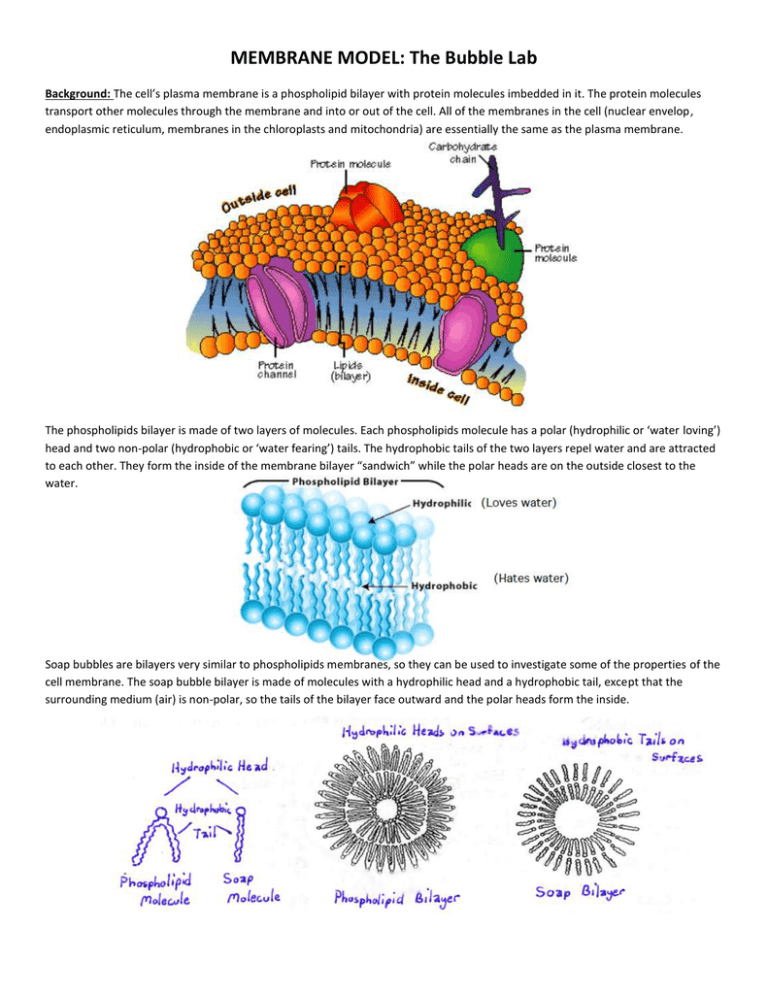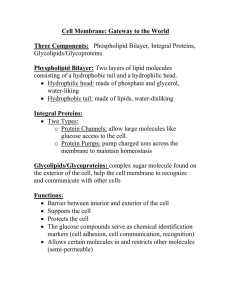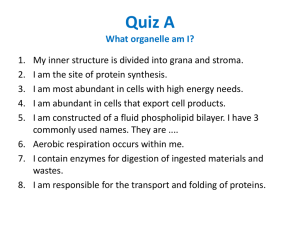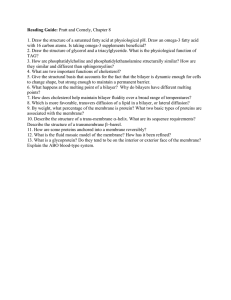MEMBRANE MODEL: The Bubble Lab
advertisement

MEMBRANE MODEL: The Bubble Lab Background: The cell’s plasma membrane is a phospholipid bilayer with protein molecules imbedded in it. The protein molecules transport other molecules through the membrane and into or out of the cell. All of the membranes in the cell (nuclear envelop, endoplasmic reticulum, membranes in the chloroplasts and mitochondria) are essentially the same as the plasma membrane. The phospholipids bilayer is made of two layers of molecules. Each phospholipids molecule has a polar (hydrophilic or ‘water loving’) head and two non-polar (hydrophobic or ‘water fearing’) tails. The hydrophobic tails of the two layers repel water and are attracted to each other. They form the inside of the membrane bilayer “sandwich” while the polar heads are on the outside closest to the water. Soap bubbles are bilayers very similar to phospholipids membranes, so they can be used to investigate some of the properties of the cell membrane. The soap bubble bilayer is made of molecules with a hydrophilic head and a hydrophobic tail, except that the surrounding medium (air) is non-polar, so the tails of the bilayer face outward and the polar heads form the inside. Discovering the Cell Membrane! This activity will demonstrate the properties of the cell membrane and show you how those properties help the cell membrane regulate what enters and exits the cell. Materials : Pan with soap mixture “membrane holder” – made of straws Straw, Straightened paper clip, Thread 5” long; Yarn 5” long Soap mixture – store bought is fine, or you can make your own (900 ml water + 100 ml Joy liquid soap + 25 ml glycerin or corn syrup) Procedure: **STUDENTS number and write descriptions in your lab notebook** A) Pour soap solution to about 1 cm. depth in your pan. Be careful not to make froth as you pour. 1. Create a Cell Membrane film. What did you have to do make sure the film didn’t pop? 2. What do you see when you hold the film up to the light? Describe color, shape, movement •This demonstrates Fluidity: The theory of the structure of the cell membrane is called the Fluid Mosaic Model. This means that the membrane is made of a pattern of many small molecules that are moving around and shifting position. 3. How flexible is the structure? Can you make the film twist and bend without popping? What made the film pop? What could you create without popping the film? •This demonstrates Flexibility: A lipid bilayer is a fluid arrangement within which the molecules can move freely through the plane of the bilayer. They can reorganize themselves into almost any shape without losing the contacts that satisfy their mutual attraction. The soap bilayer is actually less flexible than a cell membrane because a cell membrane is supported on both sides, one side by the cytoplasm and the other by lymph or other tissue fluids. So, whatever you are doing to the soap film, plus more, can be done to cell membranes without breaking them. 4. Make the film pop! Use the items on your table to make the membrane film pop. What do all of the items have in common? What did you have to do with the items to make the film pop? Don’t pop the film! Use the items on your table and pass them through the film. DON’T let the film pop! What do you think is happening? Make your finger, hand and whole arm pass through the membrane. What did you have to do? Watch the membrane film closely, what’s happening? •This demonstrates Self-Sealing: Remember that the membrane is not a solid. It is made of two layers of many molecules attracted to each other. This also allows some molecules to diffuse (enter and exit) across the cell membrane as needed because those molecules are similar in polarity with the cell membrane. 5. Make a tunnel and move items through the membrane film. Use the items on your table (try using dry and wet items) to create a tunnel that can move other items through the membrane without popping the membrane. What did you do? What tunnels did you create? Move the tunnel around the membrane without popping it. Can this be done? Why or why not? •This demonstrates Transport Proteins: In a cell membrane, small molecules such as water can sometimes move into the cell through small spaces in the lipid bilayer. Larger polar molecules cannot pass through the membrane because of the non-polar tails in the interior of the membrane. The only way these molecules can pass in and out of the cell is through channels created by protein molecules in the membrane. The proteins form a polar tunnel through which the molecules can pass.








